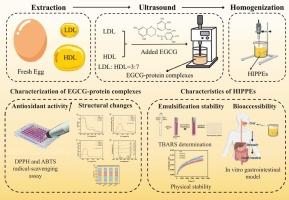egcg -蛋黄蛋白复合物-稳定的hipes用于增强亲脂性生物活性的传递:结构和功能关系的洞察
IF 9.8
1区 农林科学
Q1 CHEMISTRY, APPLIED
引用次数: 0
摘要
蛋白质和多酚的非共价复合物为传递亲脂性生物活性提供了界面特性和抗氧化保护。本研究将蛋黄中提取的低密度脂蛋白和高密度脂蛋白(3:7,w/w)与表没食子儿茶素没食子酸酯(EGCG, 0、10、20、40 μg/mL)结合,经20 kHz、75 w、10 min超声处理,形成蛋白-EGCG复合物。系统地表征了这些配合物的结构和界面性质,并随后应用于稳定负载植物甾醇酯(PEs)的高内相皮克林乳液(hips)。光谱和流变学分析证实,EGCG通过氢键和疏水相互作用诱导部分蛋白质展开,增强界面吸附。含有10或20 μg/mL EGCG的hips表现出最佳性能,包括减小液滴大小,改善界面粘弹性,高zeta电位(31.5 mV),并增加pe在消化过程中的生物可及性。而40 μg/mL的EGCG则引起蛋白质聚集和双乳形成,影响乳状液的稳定性和消化。这些发现揭示了EGCG的浓度依赖的双重作用,并确定了平衡乳状液稳定性和营养物质释放的最佳范围。本研究为食品中亲脂生物活性的功能性乳剂的设计提供了一种策略。本文章由计算机程序翻译,如有差异,请以英文原文为准。

EGCG-egg yolk proteins complexes-stabilized HIPPEs for enhanced delivery of lipophilic bioactives: Insight into structure and function relationship
Non-covalent complexes of proteins and polyphenols provide interfacial properties and antioxidant protection for delivering lipophilic bioactives. In this study, low-density lipoprotein and high-density lipoprotein (3:7, w/w) extracted from egg yolk were combined with epigallocatechin gallate (EGCG, 0, 10, 20, 40 μg/mL) and subjected to ultrasound treatment (20 kHz, 75 W, 10 min) to form protein-EGCG complexes. The structural and interfacial properties of these complexes were systematically characterized and subsequently applied to stabilize high-internal-phase Pickering emulsions (HIPPEs) loaded with phytosterol esters (PEs). Spectroscopic and rheological analyses confirmed that EGCG induced partial protein unfolding via hydrogen bonding and hydrophobic interactions, enhancing interfacial adsorption. HIPPEs containing 10 or 20 μg/mL EGCG exhibited optimal properties, including reduced droplet size, improved interfacial viscoelasticity, a high zeta potential (31.5 mV), and increased bioaccessibility of PEs during digestion. In contrast, 40 μg/mL EGCG caused protein aggregation and double-emulsion formation, impairing emulsion stability and digestion. These findings reveal a concentration-dependent dual role of EGCG and identify an optimal range for balancing emulsion stability and nutrient release. The study provides a strategy for designing functional emulsions for lipophilic bioactives in food applications.
求助全文
通过发布文献求助,成功后即可免费获取论文全文。
去求助
来源期刊

Food Chemistry
工程技术-食品科技
CiteScore
16.30
自引率
10.20%
发文量
3130
审稿时长
122 days
期刊介绍:
Food Chemistry publishes original research papers dealing with the advancement of the chemistry and biochemistry of foods or the analytical methods/ approach used. All papers should focus on the novelty of the research carried out.
 求助内容:
求助内容: 应助结果提醒方式:
应助结果提醒方式:


